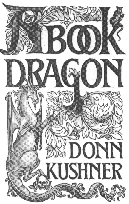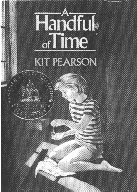






|
1987 Notable Canadian Fiction
By Debbie Taylor
Volume 17 Number 1
"GUARD YOUR TREASURE .... A dragon without a treasure is nothing but an ugly flying reptile with even less dignity than a salamander, less dignity than a turtle, and with no more than a toad." 
This is the first lesson that crotchety Grandmother Dragon teaches her grandson Nonesuch in Donn Kushner's A Book Dragon. Her second lesson is to be suspicious of humans, whom Grandmother Dragon regards as cunning cowards, dastardly and dangerous to a dwindling dragon population. Nonesuch takes Grandmother Dragon's first precept so much to heart that when she disappears into the molten centre of the Earth, he attempts to move her treasure in after her. In the process, he suffers a chemical change, which ever afterwards gives him the ability to regulate his size by the frequency of his meals, so that he can shrink to the size of a honeybee or grow to dinosaur proportions at will. When young Nonesuch discovers that toads and turtles have the dignity that comes of understanding their place in the universal scheme, he begins to discard his grandmother's prejudices. Brother Theophilus, a monk illuminating a book of hours, recognizes Nonesuch as a "true small dragon" and paints him and other dragons into the book's margin. From the monk, Nonesuch develops respect and admiration for human creativity and intelligence. His commitment to books is strengthened when the lovely Book of Hours is stolen. He adopts the Book as his treasure and becomes its Protector. Having shrunk to the size of a cockroach, Nonesuch sleeps inside the book through the centuries to modern times. He awakens during the Great Plague and befriends a rat who teaches the tiny dragon to read. When he next awakens, he finds that his book has become the treasured property of an old bookseller. When the bookshop is threatened by an unscrupulous land developer, Nonesuch rises to the occasion and demolishes the developer in a uniquely dragonish way--thereby preserving the bookshop and perhaps, as his ghostly grandmother implies, mankind from being destroyed by the Great Dragon. To this day, Nonesuch guards the Book of Hours: "he regards it with deep affection since it brought him into the present world of books which frankly interests him more now." Nonesuch is a charming character with whom ten-year-old readers will identify as they journey vicariously through time and space to the imaginary worlds presented in notable fiction for middle grade readers. Donn Kushner's writing is literate and lively. His plot is engrossing and his characters are appealing. He illuminates the joys of literacy, which young independent readers are beginning to recognize. Another notable writer who sheds light on how the imagination can define, clarify and put into perspective everyday events is Jean Little in Little by Little. Nearly blind since birth, Jean Little overcame many odds to earn her B.A. from the University of Guelph and she became an outstanding writer of award-winning novels and poetry for young people. Not entirely factual, this imaginative autobiography illustrates how good writers turn everyday events into humorous stories that both entertain the reader and explain the writer's purpose. Jean's overall message is that youngsters should refuse to be handicapped by personal fears and defeats and should strive to achieve their highest goals. She manages in Little by Little, as in her novels, to express this theme in an amusing way that will convince young readers and writers-to-be that their imagination and introspection are valuable personal attributes. Like many middle graders themselves, Jean often found respite from personal trials in stories: those she read and, increasingly, those she told and eventually wrote. Words gave her power. Today her words are read by millions of young readers across North America. This is an important book, which illuminates the mind and soul of one of the most notable Canadian writers of middle grade fiction today. Little Jacob Snyder in Barbara Smucker's Jacob's Little Giant is an example of a youngster with personal battles to fight. The baby of his Mennonite farm family and small for his age, Jacob worries that he will never be big enough to count. His favourite quotation is " little drops of water, little grains of sand, make the mighty ocean and a pleasant land'. It could mean that even little people were important," he thinks. The Snyder farm is chosen by the Ministry of Natural Resources to be a "co-operator" in reintroducing giant Canada geese to Ontario. Jacob's father appoints him the Giants' protector. Jacob is pleased but scared: how could someone as small as he protect a giant? As the summer progresses, goslings are born and begin to thrive under Jacob's watchful care. One gosling is smaller than the other, a runt, whom Jacob dubs "Little Giant." Little Giant is injured trying to protect the gander from hunters. Jacob "talks" the gosling into coming close enough so that the conservation officers can treat him. Miraculously, Little Giant survives and returns to the pond, able to swim and fly. By summer's end, the goslings are big enough to migrate with the giant Canada geese. The Natural Resources officer praises Jacob for having done the best Job of all the co-operators, and Jacob is ready to face friend Amos and school with renewed confidence. Barbara Smucker gives us a bird's eye view of life in rural Ontario among the Mennonite farmers. Middle grade readers are eager to experience unfamiliar places and cultures. They love stories that show young people competently contributing to a better world. Jacob's Little Giant fulfils these criteria and gives us an appealing character in young Jacob. Time travel is a common device in children's literature. Two books that successfully integrate this device are Cora Taylor's The Doll and Kit Pearson's A Handful of Time. In both stories, the characters travel into the past and the experience helps them deal with the emotional strain of an impending family break-up. In Cora Taylor's story, invalid Meg is taken to her grandmother's house to recover from rheumatic fever while her parents decide how best to arrange her life now that thy are divorcing. Meg fears the impending family crisis, but as her parents have not included her in their decision, she is still able to deny the awful truth. Grandmother Cameron gives Meg a china doll named Jessie, "the invalid doll," so-called because children in the family have traditionally been allowed to hold her only when thy were sick. Through Jessie's intervention, Meg slips backwards in dreams to become Morag, a pioneer child whose family is travelling by horsedrawn wagon across the prairies to Fort Carleton. Meg returns to Morag and her family more and more often. The love and security that the pioneer family fosters are enticing. Meg almost decides to remain as Morag and thereby escape the pain and isolation caused by her parents' impending divorce, but something happens that prevents Meg from permanently assuming Morag's identity. When a recovered Meg takes charge of her life in the present, she discovers what happened to Morag. This book works on many levels. First and foremost, it is a good read. Middle graders will identify with confused Meg and with spunky Morag. They will accept the final fusion of Meg and Morag's spirit, which enables Meg to face her new life with resolve. The time travel device is handled believably, coupling family tradition with the effects of an illness. The pioneer setting and the interrelationships among Morag's family are interesting and funny. Cora Taylor's ear for childlike dialogue and her eye for turning everyday events into humorous happenings rival Jean Little's. On a deeper level, the book conveys an important message: 'Take charge of your own life. Don't let events beyond your control cloud your future." Books that show young people realistically coping with the devastating emotional effects of family upheaval are important contributions to children's literature today. Kit Pearson's A Handful of Time, the CLA award-winner for 1988, is also about a troubled young girl whose trip to the past helps her to resolve her feelings about her parents' divorce. Only child Patricia Potter is sent unwillingly to visit her cousins at their summer cottage. She doesn't fit in with her cousins and their friends. She feels "different," partly because of her family situation, and so becomes isolated from the group. Unhappy, alone and confused, Patricia withdraws to a dilapidated guest cottage on her aunt's property. There she finds an old pocket watch hidden under the floorboards. She winds the watch and, in so doing, travels backwards in time until she is able to observe her mother as a young girl. From then on, she spends many hours watching her mother battle her own domineering mother for a place in the sun equal to that accorded her brothers. Patricia gains an understanding of what drives her super-achiever mother. She can identify with her pride and loneliness. She begins to accept her mother's determination and to forgive her for the ambition, which Patricia senses may have driven her more relaxed father from the family. In the end Patricia resolves her ambivalence towards her mother and reasserts herself in her cousins' world. This story will probably appeal more to girls than boys, and perhaps most of all, to those experiencing preadolescent problems with their mother. It shares with Cora Taylor's The Doll the theme of individual growth and with Joan Clark's The Moons of Madeleine the theme of gathering strength from an unbroken, if troubled, cord linking grandmother to mother to daughter. The narrative reads well with a slightly old-fashioned, untimely quality, which suits the time-travel device very well. 
The lakeside setting evokes a time when many Canadian families valued the respite from urban pressures they experienced by retiring to a country life-style for a few weeks each summer. Today's youngsters may enjoy escaping vicariously from modern pressures to the relaxed life-style of an era just past, which Kit Pearson evokes so strongly in A Handful of Time. A variety of notable books from Canadian authors for middle grade readers were published in 1987. is important that these materials be presented to Canadian youngsters in a way that will encourage them to read about their world through a uniquely Canadian perspective. Young people often Judge a book by its cover and title, and Canadian publishers have made improvements in cover art design in recent years. Books like Kit Pearson's A Handful of Time have appealing cover art and imaginative titles. Others, like Donn Kushner's A Book Dragon, show great attention to and care for the cover art and page design, but the details may be lost on young readers. who might be more attracted to a colourful portrait of the dragon. Cora Taylor's book could have had a title that might appeal more to both sexes and to older children, who may never pick up a book "about dolls." These quibbles aside, I urge you to stock your shelves with notable Canadian books for middle grade readers. Remember, along with Jack Prelutsky, what a pleasurable escape books provided. I Met a Dragon Face to Face I met a dragon face to face I stowed abroad a submarine I found a pot of gold Jack Prelutsky 1987 Notable Canadian Fiction Kushner, Donn. A Book Dragon. Macmillan, 1987. Smucker, Barbara. Jacob's Little Giant. Viking Kestrel, 1987. Little, Jean. Little by Little. Penguin Books Canada. 1987. Clark, Joan. Moons of Madeleine. Viking Kestrel. 1987. Taylor, Cora. The Doll. Western Producer Prairie Books, 1987. Pearson, Kit. A Handful of Time. Viking Kestrel. 1987. |


1971-1979 | 1980-1985 | 1986-1990 | 1991-1995

The materials in this archive are copyright © The Manitoba Library Association. Reproduction for personal use is permitted only if this copyright notice is maintained. Any other reproduction is prohibited without permission
 Digital Collections / Collections Numérisees
Digital Collections / Collections Numérisees
